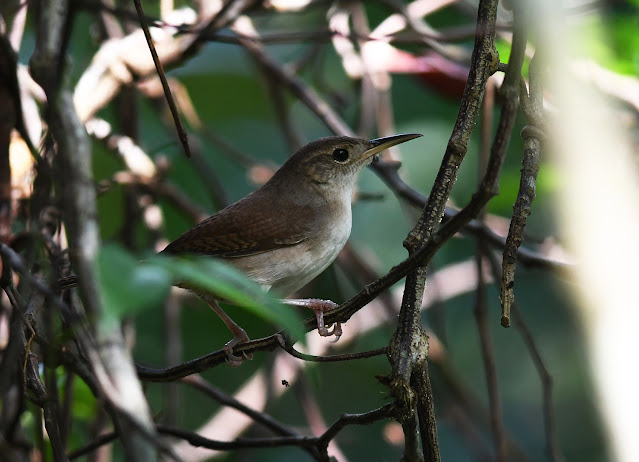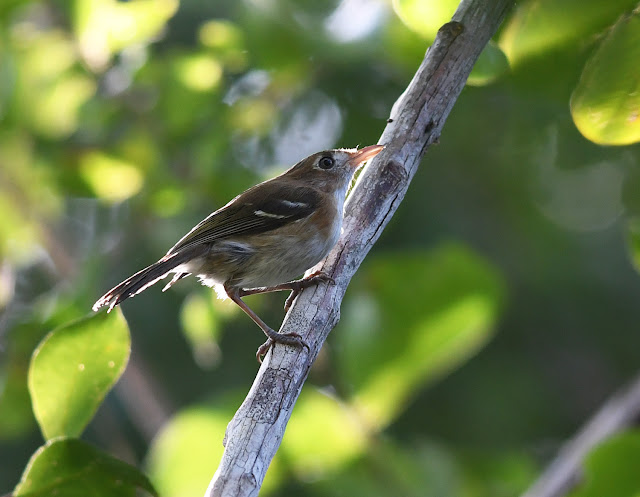It was hard to believe that our time in Mexico was coming to a close, but we had seen so much in the past five weeks. To close out the trip, we booked two nights on the island of Cozumel.
Originally, our plan had been to stay on Isla Cozumel for three nights, but we had to rejig our flights back to Canada and it cut one night off the total. Even with only two nights on Cozumel we had no problem finding all of our target birds, though an extra night would have been nice so we could explore a few other areas.
One aspect of island biogeography is that islands are perfect laboratories for speciation to take place. Populations of an organism that somehow end up on an island are now reproductively isolated from the source population, and over time may evolve and change without gene flow occurring between the island population and the source population. Given enough time, the island population is unique enough that it may be determined to be a new species.
 |
| Blue-gray Gnatcatcher (Cozumel ssp.) - Isla Cozumel, Quintana Roo, Mexico |
Isla Cozumel is approximately 19 km east of the Yucatan Peninsula in the Caribbean Sea. At roughly 478 square km in area, it is the third largest Mexican island. And, like many islands around the world, it is home to a number of species that are not found anywhere else; species that have evolved over time on Isla Cozumel.
Bird-wise, these include three species: the Cozumel Thrasher, Cozumel Emerald and Cozumel Vireo. The Cozumel Thrasher used to be common on the island but it may now be extinct. There have not been any confirmed reports since 2004; its demise accelerated by a number of factors including predation by introduced Common Boas (Boa imperator) and habitat degradation caused by hurricanes. The Cozumel Emerald and Cozumel Vireo are both common residents on Cozumel, however.
 |
| Cozumel Emerald - Subdivisión Abandonados, Cozumel, Quintana Roo, Mexico |
In addition, there are several other forms that may or may not be distinct enough to be considered unique species. These include subspecies of House Wren, Rufous-browed Peppershrike, Bananaquit, Great Curassow, Yellow-faced Grassquit, Blue-gray Gnatcatcher, Western Spindalis and more.
 |
| Rufous-browed Peppershrike (Cozumel ssp.) - Isla Cozumel, Quintana Roo, Mexico |
Laura and I changed things up and rented bicycles for our two days on Cozumel. Despite incurring two flat tires, this was a great way to see the island, a more economical option compared to renting a car or a scooter.
One benefit of cycling on Cozumel is that it enabled us to see some wildlife that we otherwise would have missed, such as this Yucatan Rust-rump Tarantula that was crossing the sidewalk.
 |
| Yucatan Rust-rump Tarantula (Tlitocatl epicureanus) - Cozumel, Quintana Roo, Mexico |
Laura and I only birded for part of our visit on Cozumel; we also allocated some hours to the beach and snorkelling. The only site that we explored thoroughly was the abandoned subdivision located south of San Miguel de Cozumel. I am not sure the story behind this subdivision and why it was abandoned, but the paved grid of roads provide access to decent woodland habitat.
 |
| Subdivisión Abandonados, Cozumel, Quintana Roo, Mexico |
Laura and I easily found Cozumel House Wrens and Cozumel Emeralds in several locations throughout the abandoned subdivision. The entrance road was the best for the wren, while the emerald seemed reasonably common throughout the actual subdivision.
 |
| Cozumel Emerald - Subdivisión Abandonados, Cozumel, Quintana Roo, Mexico |
 |
| House Wren (Cozumel ssp.) - Subdivisión Abandonados, Cozumel, Quintana Roo, Mexico |
The Cozumel Vireo is said to be the most common of these three species, but it was our final Cozumel endemic to fall (not counting the thrasher, of course). We found a pair in the abandoned subdivision at 20.456145, -86.960404. A pretty unique looking bird, and one I had been looking forward to seeing.
 |
| Cozumel Vireo - Subdivisión Abandonados, Cozumel, Quintana Roo, Mexico |
Two other targets of mine were the Caribbean Dove and Caribbean Elaenia. The dove was a little tricky and the only ones we actually saw flushed from the roadside before a great view could be had. The elaenia was a little more accommodating, however. This species has a somewhat disjunct range; mainly the Lesser Antilles, but also San Andrés and Providencia, the Cayman Islands, and the eastern Yucatan Peninsula and offshore islands of Belize. They, too were quite common in the abandoned subdivision, being one of the few vocal birds at this time of year.
 |
| Caribbean Elaenia - Subdivisión Abandonados, Cozumel, Quintana Roo, Mexico |
We found most of the unique subspecies to Cozumel Island, not counting the very rare Great Curassow. The endemic rufivertex subspecies of Yellow Warbler shows a rufous crown, a feature that can be used to tell it apart from the migrant Yellow Warblers that appear in the autumn.
 |
| Yellow Warbler (Cozumel ssp.) - Subdivisión Abandonados, Cozumel, Quintana Roo, Mexico |
Here is the endemic intermedia subspecies of Yellow-faced Grassquit, which has less extensive black on its chest compared to the mainland birds.
 |
| Yellow-faced Grassquit (Cozumel ssp.) - Subdivisión Abandonados, Cozumel, Quintana Roo, Mexico |
We only found one Rose-throated Tanager (endemic subspecies cozumelae) and it did not really cooperate for photos.
 |
| Rose-throated Tanager (Cozumel ssp.) - Subdivisión Abandonados, Cozumel, Quintana Roo, Mexico |
And lastly, the endemic benedicti subspecies of the Western Spindalis.
 |
| Western Spindalis (Cozumel ssp.) - Subdivisión Abandonados, Cozumel, Quintana Roo, Mexico |
I returned to the abandoned subdivision on the evening of December 13 for one final attempt at the Yucatan Nightjar. While I waited for night to fall I explored some areas on bike, finding my first Black-throated Blue Warbler for Mexico as well as a Collared Peccary in a makeshift garbage dumping area.
 |
| Collared Peccary - Subdivisión Abandonados, Cozumel, Quintana Roo, Mexico |
And finally, it happened - I lucked out with the nightjar. It repeated a few iterations of its song thirty minutes after the sun had set. I hung around in the area, waiting and listening, but it would not come any closer and I was unable to obtain a visual on the bird (the location of the bird was north of 20.457748, -86.958607). This was my last Yucatan endemic, though it remained heard-only alongside the Yucatan Poorwill.
December 14, 2021
With all targets acquired, Laura and I enjoyed a bit of a sleep-in before hitting the road on our bicycles. We chose an area not far from our location - a planetarium that also seemed to be a popular birding spot, based on eBird. Laura still had two "lifer" possibilities on Cozumel - Swainson's Warbler and Green-breasted Mango.
 |
| Ovenbird - Planetario Cha'an Ka'an de Cozumel, Cozumel, Quintana Roo, Mexico |
Unfortunately, we were unable to turn up a Swainson's Warbler along the short trail behind the planetarium, though there was a nice selection of wintering warblers present. We staked out some orange flowers directly behind the planetarium as well, and while a single Green-breasted Mango buzzed us, we were unable to obtain great views. Several Cozumel Emeralds provided a nice study.
We slowly made our way back to San Miguel de Cozumel to return the bikes, stopping along the breakwall to scan for shorebirds, terns, and gulls.
 |
| Birding in San Miguel de Cozumel, Cozumel, Quintana Roo, Mexico |
Our last birds of interest were a few Ruddy Turnstones, flipping rocks only a few metres from us along the rocky shoreline.
 |
| Ruddy Turnstone - San Miguel de Cozumel, Cozumel, Quintana Roo, Mexico |
 |
| Ruddy Turnstones - San Miguel de Cozumel, Cozumel, Quintana Roo, Mexico |
We returned the bikes, walked back to our AirBnB (picking up some delicious ice cream along the way!) and were driven to the ferry docks by our generous AirBnB host. Our ferry motored back across the channel to Playa del Carmen. Laura and I enjoyed one last night in the area and made use of the rooftop pool at our hotel. The next day we boarded a bus to the Cancún airport, and we had no issues flying back to Canada.
Laura and I really enjoyed our time in Mexico. We tallied almost 530 species of birds (including nearly every one of the big targets!), found a handful of snakes, enjoyed a nice diversity of cuisine, met some amazing people, and had no issues at all in five and a half weeks. My only regret is that we were unable to do any mothing and had limited time devoted to searching for snakes. I'm already perusing eBird to help formulate a plan in west Mexico, whenever my next trip to Mexico will be!


No comments:
Post a Comment